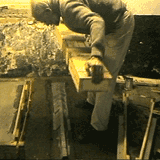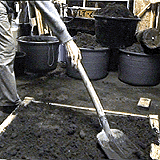
This is about the construction of Bathroom Toilet units affordably. It aims at improving sanitation in rural settings. This method is meant to be used in a communal project where inhabitants of a village can be motivated to build a private bathroom for every family around. To achieve this each family works on its own bathroom facility concurrently while sharing experience and guidance. A special construction method is used to permit this.
How[edit | edit source]
Properties of the Bathroom Toilet-unit
- A comfortable space for bathing, also to be used for sanitation, aesthetically pleasing, decorated, easy to clean,
- Sufficient space for a parent to bath a small child and to teach it the proper use of a toilet.
- Waste water from bathing rinses urine away, minimizing stink and use of flush water.
- The bathroom/toilet unit can be configured as a composting toilet or to dry-fill a dug out, the choice is left to the future users and will be based on the way how users look at sanitation.
- The cost of the bathroom/toiltet unit is only the cost of one bag of cement. The work can be done by the adults and children of each family with guidance from an instructor.
- MOST IMPORTANT, the method of construction is adjusted to a communal project. With some guidance of sanitation helpers (like WaterAid) the local carpenter makes a true scale model in wood of the toilet slab, gutter and other parts. Everybody can imagine what it will be like when later copied in concrete. With a special but simple trick an accurate impression or mold of the slab can be made into the dirt. Then concrete with some reinforcement is cast into the mold. Two such slabs and a gutter make one toilet. Personal decoration of the slabs is done by putting colored stones or bits of tiles in the mold before the concrete is poured over it.
- MOST IMPORTANT, with the one wooden model of the slab all the cast forms for all the families around can be made within a few weeks.Thus ALL the families then own a private bathroom sanitation unit of high quality.
- When ALL the families in a neighbourhood use their own toilet this results in far less illness, especially for children. If only a small part of the total area population were to be left out this life-saving health improvement would not be attained.
- How to instruct the populace on how and why the new bathroom facilities should be used?
It is not clear how users should best be instructed on how to use the toilet. The following options are being considered:
- Children are instructed at school (preferably the local school takes the lead with improving sanitation).
- At home it is the task of the mother to instruct and guide the children and female visitors.
- It is the task of the man at home to instruct male visitors. He should monitor that the proper hygienic condition of the toilet is maintained. When feces is to be composted, he should change the use of one container to the other in a timely fashion.
- If feces is not reused, he should prepare the new pit and plan move the bathroom/toilet unit to this new site before the current one is overfilled..
The Bathroom/Toilet unit was used like this for many years at Demotech's own workshop.
With wooden copies of the final concrete parts made, imprints of the parts may be made in the soil near each dwelling. These imprints serve as a mold to cast the concrete parts in.
Work in a village for this project is split up in eight parts:
- Making the wooden copies of the concrete parts for the bathroom/toilet, the slab and the gutter
- Making two imprints of the wooden slab in the dirt using the wooden mold
- Making one imprint of the gutter in the dirt using the wooden mold
- Making the slab: line the soil imprint with paper or plastic, add concrete, reinforce, compact and finish
- Making the gutter: line the soil imprint with paper or plastic, add concrete, reinforce, compact and finish
- Prepare for composting: build the sub-structure with two cellars under the slabs
- Or prepare a temporary pit top construction that can be moved when the pit is full
- Assemble and decorate the Bathroom/Toilet unit and use it
Making the Wooden Molds for the Concrete Slab and Gutter[edit | edit source]

Construct the slab and gutter molds with the local carpenter and his/her helpers. These are wooden replica's of the concrete parts to be cast later.
(Note; This would be an appropriate place to have a dimensional drawing of the plans not just a picture)
Make Two Imprints with the Wooden Slab Mold[edit | edit source]
With the wooden mold of the slab make two imprints in moist dirt. The latest working method is to set the slab mold face up, fill with dirt, flatten and compact the dirt level with the top of the sides of the mold then quickly turn the slab over to a face down position. Moist dirt is then compacted around the sides of the mold to form the sides of the imprint. Finally, with great care, the wooden copy is lifted off the imprint. Often small repairs are needed, to the now almost complete imprint, which can be done with mud and something flat to fill and smooth imperfections.
Make One Imprint with the Gutter Mold[edit | edit source]

The imprint of the gutter is made in the same way as the slab imprints. Again the top of the wooden copy is filled with dirt that is compacted and flattened.
Then the gutter mold is turned over, dirt is compacted against the sides of the mold which is then lifted off.
WARNING These imprints are easily damaged, keep small children, goats and dogs at a distance. Keep moist until used and cover it to protect against sun and rain.
Best practice is to cast concrete parts immediately!
Casting the Concrete Parts[edit | edit source]

Prepare concrete to a consistancy similar to moist mud, not watery mud. To achieve this add water in small amounts while mixing. Before adding concrete cover the surface of the mold imprints, the slab and the gutter imprints, with oiled paper. This prevents the water in the cement from seeping away into the soil form. Reinforce the concrete with scrap such as wire or sheet metal strips. Take care that these bits of wire or sheet metal are not pushed in too far such that they stick through the concrete into the dirt of the imprint. All concrete casts should get ample time to set and harden. In the meantime, keep them wet and prevent damage by animals.
Preparing for Composting: Build two Cellars Under the Slabs[edit | edit source]

With the two slabs and the gutter ready for assembly it is easier to decide where the bathroom will be situated, in the house or near it. Now it has to be decided whether to compost the excreta or to collect them in a deep pit. Composting is STRONGLY recommended.
A double composting cellar is known from sanitation projects in Vietnam and India.
A drain has to be made for the water used in the bathroom, also containing the urine of its users. This spill water could also be collected as fertilizer. It contains essential agricultural nutrients. However, the odour from the collection of urine has to be prevented. One possible method is for the fluid to be piped to a subsoil root zone of a tree or shrub. If this is to be done it is necessary to dilute the urine approximately 4-1 with water so that plant roots are not chemically burned. This disposal method has the benefits of controlling odour, providing a nitrogen source for plants and supporting food plants, such as berry bushes, without exposing the food portion to contamination.
Option 2; Preparing a Temporary Pit Top Construction[edit | edit source]
If composting human excreta is neither practical nor acceptable for the future users, the Bathroom/Toilet can be assembled over a deep pit. Spill water from the Bathroom/Toilet can best be guided to a sink, as in a separate pit filled with gravel or sand, and not directly into the main pit. This will reduce the odour coming from the pit. When the pit is nearly full prepare a new pit, move the Bathroom/Toilet to the new pit and fill in the old. As the material in the old pit decomposes be prepared for the area to slump. This may require adding more material to the cap.
WARNING Do NOT dig the pit deep enough to be close to groundwater as this will contaminate the water making it unsuitable for drinking. Pits must NOT be dug close to a water well for similar reasons. Contaminants WILL migrate through soil! For this reason composting of waste is much preferred to pit disposal! Water is a valuable resource.
Finishing the Bathroom Toilet Unit[edit | edit source]

A neat separation has to be made around the slabs and gutter assembly. The entrance is best situated in the middle of the wall, above the gutter.
The opening in the slab for defecation can best be closed with a concrete block cast similarly to casting the slabs, see picture.
Be sure future users receive proper instruction on how to use and maintain the toilet.

